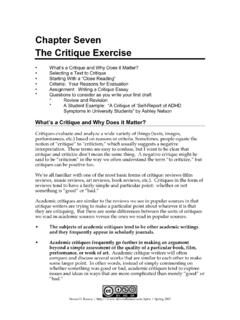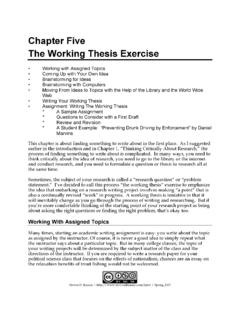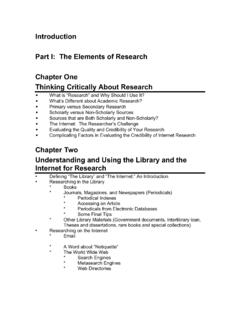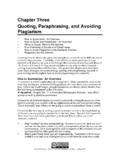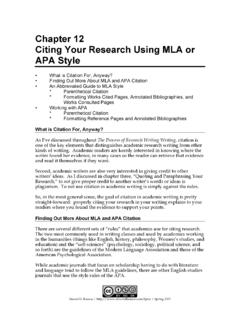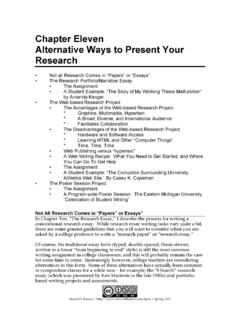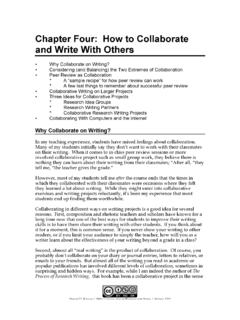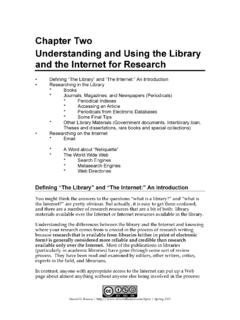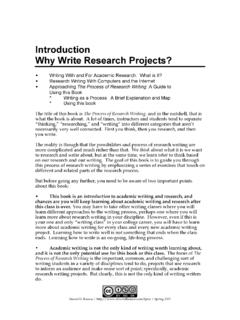Transcription of Chapter Nine The Categorization and Evaluation …
1 Steven D. Krause | | Spring 2007 Chapter Nine The Categorization and Evaluation exercise Revisiting your Working Thesis Why Categorize and Evaluate Evidence? Dividing, Conquering, Categorizing: A Few Rules to Follow Some Sample Categories Charting Your Categories Assignment: Writing the Categorization and Evaluation exercise * Questions to consider as you write your first draft * Review and Revision * A Student Example: Categorizing My Research on Drug Advertising by Jeremy Stephens Revisiting your Working Thesis Again Before you start working on the Categorization and Evaluation exercises, you should revisit the progress of your working thesis.
2 In Chapter eight, I began the discussion of the antithesis essay by encouraging you to first take a moment to take stock of the current version of your working thesis. It s important to embark on research projects with some sense of where you re going, and the main advantage and goal of a working thesis is it establishes a direction for you to pursue your research. As I ve also said before, your working thesis will almost inevitably change a bit as you work your way through the process of research writing and the exercises in this book. You begin in one place with some sense of direction about what you want to research, but when you start gathering and examining your evidence and as you work through the exercises, it s important to be willing and able to change directions.
3 In other words, a working thesis is where you start your research project, but it isn t necessarily where you end your research project. The Process of Research Writing Chapter Nine, The Categorization and Evaluation exercise , 2 Steven D. Krause | | Spring 2007 exercise Either as a short writing exercise or with a group of your peers, consider once again the evolution of your working thesis. Where did it start out and how has it changed to what it is now? What sparked these changes in your working thesis and your point of view on your topic? If your working thesis has not changed yet, why do you think this is the case?
4 If you did revisit your working thesis at the beginning of Chapter 8, did the antithesis essay project (also in Chapter 8) make you reconsider your working thesis again? Why or why not? Why Categorize and Evaluate Evidence? We divide things into categories in order to make some sense of and interpret all sorts of different things. Stores are arranged according to categories that tend to make sense of what s in them for shoppers for example, department stores divide their merchandise up into categories like women s clothing, hardware, sporting goods, housewares, and so forth. We also expect things to be categorized in a descriptive and sensible way.
5 Department stores tend to arrange things by what you might use them for and who might use them: kitchen things are in one part of the store, sheets in another, women s clothing in one part, and men s clothing in still another part. These categories aren t the only way the department store owners could arrange things. They could arrange things by color all of the blue things in one part of the store (blue cookware, blue sheets, blue shirts, etc.), all of the white things in another part of the store, and so forth. While that might make for a visually interesting store, it would be very difficult for customers to find anything in such an arrangement.
6 Categorizing your research will: Help you (and eventually your readers) make better sense of what sort of evidence you have. Enable you to compare and contrast different pieces of evidence and to evaluate your research, which is an essential step in the process of research writing. Give you get a clearer sense of the evidence that you have and the evidence you are lacking. The Process of Research Writing Chapter Nine, The Categorization and Evaluation exercise , 3 Steven D. Krause | | Spring 2007 Dividing, Conquering, Categorizing: A Few Rules to Follow While there are no formal rules for categorizing your research, there are a few guidelines that you need to consider as you begin to categorize your research for the purposes of writing about and evaluating it.
7 You have to have a significant body of research to categorize in the first place. Hopefully, you have started compiling an annotated bibliography (see Chapter six) and you have been working on adding to your annotated bibliography as you have progressed through the other exercises and projects in The Process of Research Writing by gathering materials from the library, the Internet, interviews, and so forth. If you haven t done these things yet, you probably aren t ready for the Categorization and Evaluation essay exercise . Each piece of research has to fit into a category. No matter how you decide to categorize your research, be sure that all of it can be put into at least one category.
8 As you try to meet this guideline, be careful to follow the next one as well: As much as possible, each category should have at least two pieces of research. Avoid having categories with just one item. One item categories don t allow you to make comparisons or generalizations about how things might be similar; they only demonstrate how things are different, which is only one of the functions of categorizing your research. Also, if you allow yourself one item categories, it can often be a little too tempting to make too many one item categories. If you get completely stuck with what categories to put some of your evidence in, you can create a miscellaneous category, though I would encourage you to avoid it if you can.
9 Having categories that are more specific than miscellaneous will help you in writing about these categories and what they mean for your research. Categories should be as distinct and different from each other as possible. If there is no difference between the items that you put in the category from newspapers and those from the category from nonacademic sources, then put all of the sources from both categories into only one category. Last but not least, categories should make sense and tell you and potential readers about what your think of your evidence. It probably wouldn t make much sense and wouldn t be very meaningful to have a category consisting of articles that appeared on page four of newspapers, or a category consisting of articles that were published in journals with titles that begin with the letter R.
10 Sometimes, categories that might seem to be illogical actually make sense once they are explained. It might not seem to make much sense for a writer to The Process of Research Writing Chapter Nine, The Categorization and Evaluation exercise , 4 Steven D. Krause | | Spring 2007 categorize his evidence according to the gender of the authors. But if the writer is trying to make a point about how men and women hold different attitudes about the topic of the research, it might make quite a bit of sense to have at least one category that examines the gender of the source. Some Sample Categories Beyond the few general rules I just described, categorizing things can be a very idiosyncratic and specific activity.

